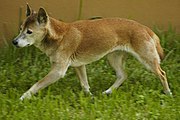New Guinea Singing Dog
 The New Guinea Singing Dog (Canis lupus hallstromi), known as NGSD, New Guinea Highland Dog, or Singer, is a type of wild dog that is native to New Guinea, classified as a subspecies of Canis lupus and related to the Australian Dingo. Singers have remained isolated from other dogs for almost 6000 years,[2] making them possibly the oldest of the pariah dogs. Once thought to inhabit the entire island of New Guinea, today dwindling wild populations are thought to still exist in the Highlands. No specimens have been sighted for years, but explorers and natives insist that they have heard their calls during the night.,[citation needed] Captive specimens number from 100 to 200.[citation needed] They are exceptionally intelligent, but hard to keep because of wild behavioural traits. With proper training and socialization, they will live with humans in a "home" environment. They are recognized as a breed by the United Kennel Club, which places them in the Sighthound & Pariah Group. A conservation group, New Guinea Singing Dogs International, provides advice and help for new or potential owners, aids in rescue of strayed or lost Singers and provides registration and pedigree services without charge. New Guinea Singing Dogs are unique in their ability to howl in a wolf-like manner, but unlike wolves, Singers modulate the pitch, hence the name.
The New Guinea Singing Dog (Canis lupus hallstromi), known as NGSD, New Guinea Highland Dog, or Singer, is a type of wild dog that is native to New Guinea, classified as a subspecies of Canis lupus and related to the Australian Dingo. Singers have remained isolated from other dogs for almost 6000 years,[2] making them possibly the oldest of the pariah dogs. Once thought to inhabit the entire island of New Guinea, today dwindling wild populations are thought to still exist in the Highlands. No specimens have been sighted for years, but explorers and natives insist that they have heard their calls during the night.,[citation needed] Captive specimens number from 100 to 200.[citation needed] They are exceptionally intelligent, but hard to keep because of wild behavioural traits. With proper training and socialization, they will live with humans in a "home" environment. They are recognized as a breed by the United Kennel Club, which places them in the Sighthound & Pariah Group. A conservation group, New Guinea Singing Dogs International, provides advice and help for new or potential owners, aids in rescue of strayed or lost Singers and provides registration and pedigree services without charge. New Guinea Singing Dogs are unique in their ability to howl in a wolf-like manner, but unlike wolves, Singers modulate the pitch, hence the name.Physical description
They have a fox-like appearance, with a double coat ranging in color from red to brown (with a melanistic mask in some individuals), and a characteristically large carnassial tooth. They stand between 14 and 18 inches (36 to 46 cm) at the shoulder and weigh 17 to 30 pounds (8 to 14 kg) as adults.
They have proportionately short legs and large heads compared to other canis. They are shorter in height at the withers than dingoes. The skull is slightly wider than a dingo's.
History and study
In the 1950s, Sir Edward Hallstrom brought the first pair out of the Southern Highlands District of Papua New Guinea to the Taronga Zoo in Sydney, Australia, and it was first classified from those specimens as a distinct species, Canis hallstromi (Troughton, 1957). Currently the NGSD is classified as a domestic dog subspecies of Canis lupus, Canis lupus hallstromi.
The New Guinea Singing Dog has never been studied in the wild and virtually nothing is known concerning its behavior, social organization or general natural history under free-ranging conditions; and as of 2004, there were less than 50 specimens (all highly inbred) in the documented NGSD captive breeding population. Most of the NGSD in North America have descended from the original Taronga Zoo pair; in 1976 five were brought from Irian Jaya to the Domestic Animal Institute in Keil, Germany. No others have been captured from the wild. One singing dog was seen in 1991 in the highlands below Mt Trikora by a British Climbing expedition.
In general, NGSD show all the behaviors described for other Canis species with the exception of the "play bow", typical to most canids but not seen in the NGSD. However, there have been cases in which NGSDs have attacked other domestic dogs due to misconstruing attempts to play. Captive populations (the only ones studied) do not form packs, and wild sightings are of single dogs or pairs. They have a distinctive howl, and emit a "trill", described as similar to a sound made by the Dhole (Cuon alpinus.)
The Kalam people of the Papuan Highlands capture pups and raise them as pets and hunting dogs, but do not breed the NGSDs. Wild dogs (not village dogs) are sometimes eaten.
The taxonomy of the NGSD continues to be investigated. Naming systems are not random, but agreed upon internationally. As new information becomes available, naming may change.
The United Kennel Club began registering them as a dog breed in January 1996, in the Sighthounds & Pariah Group. The American Rare Breed Association also registers them as a dog breed, in their Spitz & Primitive Group.

